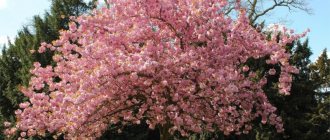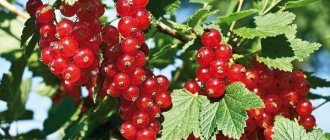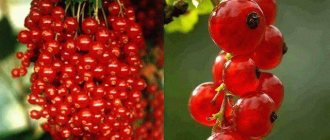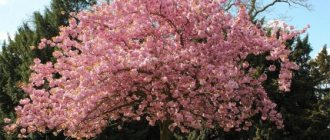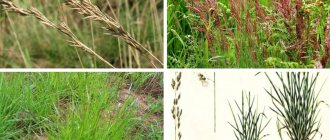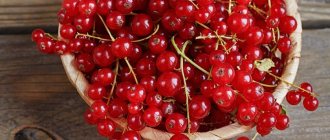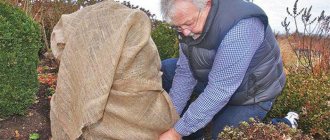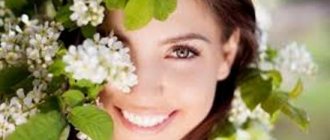Peculiarities
It turns out that the word “bird cherry” is applicable to several species of Prunus from the genus Plum, belonging to the Rosaceae family. Previously, they were considered a separate genus Radus - this point of view was shared by domestic botanists. Today they are classified into the genus Plum. When we talk about growing a plant in the garden, we most often mean bird cherry.
Bird cherry
In nature, it is found everywhere: in almost all regions of Russia, North Africa, and European countries. Prefers forest nutrient soils. Found on forest edges, river banks and sands. About 20 species are known.
- Shrub, tree up to ten meters high.
- The crown is high.
- The bark is matte, with a gray tint. Sometimes white lenticels are visible. The stems of the young plant have an olive, even cherry tint.
- The leaf blades are bare, elliptical in shape, the inflorescences are racemose.
- The flowers are fragrant, white and pale pink.
- Five-petalled flower. There are twenty stamens, the anthers are yellow.
- The fruit is a drupe. Blooms in early summer. The taste of the fruit is sweetish and astringent.
Types and varieties of bird cherry
In addition to the bird cherry, which we described at the beginning of the article, several other plant species are grown in culture.
Bird cherry (Padus maackii)
It grows naturally in the Khabarovsk and Primorsky Territories, the Amur Region, Northeast China and Korea. This species is most often used in landscaping. The species was named in honor of the Russian naturalist and researcher of the nature of the Far East and Siberia R.K. Maaka. The plant is a tree up to 17 m high with a wide pyramidal crown. Its trunk is covered with very elegant reddish-orange or golden-yellow bark that peels off in thin films. The leaves of the Maak bird cherry are shiny, oblong or elliptical, sharp-toothed, with an elongated apex, up to 13 cm long. In spring they are light green, dark green in summer, and intensely yellow or yellowish-red in autumn. Odorless flowers up to 6 mm in diameter, collected in erect oblong racemes, are painted white.
The fruits are small, round, black and bitter. Because they are a delicacy for bears, they are called “bear berries.” The species is winter-hardy and can tolerate temperatures down to -40 ºC. In culture since 1870.
Bird cherry (Padus maximowiczii)
Also a Far Eastern species, named after the Far Eastern explorer K.I. Maksimovich. It differs from other types of bird cherry in the presence of bracts on the flower cluster, which are also preserved on the fruits. The raceme contains from 3 to 7 white flowers with a diameter of no more than 6 mm. The fruits are small, red, turning black when ripe. The leaves are small, slightly lobed, turning red in autumn. Bird cherry Maksimovich is one of the most attractive species.
Bird cherry (Padus serrulata)
Grows in Japan, Korea, Northeast China, and the Far East. This species was classified either in the genus Plum or in the genus Cherry. Along with other species, finely serrated bird cherry was used to breed Japanese sakura. The species was introduced into culture a long time ago. The plant is a spreading tree up to 25 m high with an ovoid crown. Its bark is smooth, gray-brown, with long-lasting lentils. The leaves are ovate or elliptical, strongly narrowed towards the apex and rounded at the base. In early spring, the leaves are bronze or purple on the upper side, in summer they are orange and light green, and in autumn they are brown or purple. The underside of the leaves is paler than the top and is covered along the veins with appressed pubescence. White or slightly pinkish flowers up to 3 cm in diameter, collected 2-4 in short corymbs, bloom simultaneously with the appearance of leaves. Flowering bird cherry of this species is highly decorative; its white-terry and pink-terry forms are especially attractive.
- How to treat strawberries during fruiting
Pennsylvania bird cherry (Padus pennsylvanica)
Native to North America, where it grows in rich soils along rivers and on forest edges. This is a large shrub or tree up to 12 m high with a slender trunk, dressed in cherry-red bark, shiny red branches, an oval crown, green ovate or oblong-lanceolate shiny leaves with a sharp apex and sharp-serrated edges, which turn red in autumn. White flowers are collected in clusters of 3-8 pieces, the fruits are edible small drupes. Plants of this species are most decorative during the flowering period and in autumn. They are frost-resistant and drought-resistant. The species has been in cultivation since 1773.
Bird cherry (Padus ssiori)
It grows wild in the mountain forests of Southern Sakhalin, the Far East and Northern Japan. This is a tree up to 7 m high with dark gray bark with large white lenticels, a spreading crown with age, pointed to the apex, unevenly serrated along the edges, elliptical or obovate leaves up to 14 cm long with a heart-shaped base and flowers up to 1 cm in diameter, collected in multi-flowered racemes up to 15 cm long. The fruits of plants of this species are large, spherical, fleshy black drupes.
Asian bird cherry (Padus asiatica)
Grows in floodplains and forests of Eastern Siberia and the Far East. This is a tree up to 17 cm high, similar to the common bird cherry, but distinguished by the presence of reddish pubescence on young shoots and high winter hardiness.
Bird cherry (Padus mahaleb)
Or Magalenka grows in nature on calcareous soils in bushes in southern Europe, Asia Minor, the Caucasus and Central Asia to the Pamir-Altai. The Latin name of the species is of Arabic origin, but in America this species is called fragrant cherry, or St. Lucy cherry. The main difference between antipka and other species is the structure of its inflorescence, which is a flattened and shortened raceme of 5-14 flowers, more like a shield. This is a low tree or shrub with dark brown bark, which has a specific aroma, and a spherical crown. The leaves of the plant are up to 9 cm long, crenate along the edge, round, shiny, light green above and lighter, covered with yellowish pubescence below. The flowers are small, up to 1.5 cm in diameter, collected in inflorescences up to 7 cm long. The fruits are juicy, up to 1 cm in diameter, turning black as they ripen. The species has the following garden forms:
- weeping - with branches hanging down;
- yellow-fruited - the fruits of this form do not turn black when ripe;
- variegated - with spotted leaves;
- white-bordered - the edge of the leaves is surrounded by a white border;
- ugly - with a thick spherical crown.
Gray bird cherry (Padus grayana)
Tree up to 10 m high from East Asia. Has high winter hardiness. Rarely found in culture.
Late bird cherry (Padus serotina)
An American from an area stretching from the Great Lakes to the Gulf of Mexico. It got its name because its flowering occurs late - at the very end of May or June, and the fruits ripen no earlier than the end of August. It is sometimes called black cherry because of the color of its bark, and sometimes called rum cherry because of the flavor of its fruit. Late bird cherry is a tree up to 20 m high or a bush with a wide crown, very dark cherry bark, broadly lanceolate bare and shiny dark green leaves up to 12 cm long, the lower side of which is much lighter than the upper. In autumn, the foliage turns various shades of red and yellow. Fragranceless white flowers up to 1 cm in diameter are collected in cylindrical racemes up to 14 cm long, leafy at the base. The fruits are black, with obvious bitterness. The species has several decorative forms:
- pyramidal - with a narrow pyramidal crown;
- weeping - with branches hanging down;
- variegated - with green leaves with yellow spots and streaks;
- cartilaginous - with shiny long leaves;
- willow - the leaves of this form are narrow and resemble willow leaves;
- fern-leaved - a form with repeatedly dissected leaves;
- terry - with double flowers.
The species has been in culture since 1629.
Virginia bird cherry (Padus virginiana)
Grows along rivers in eastern North America. It is more similar to common bird cherry than others, but differs from it in small buds spaced from the shoot, while in bird cherry the carpal buds reach 13 mm and are pressed against the shoots. Bird cherry is a tree up to 15 cm high with a spreading crown, finely fissured dark bark, oblong-ovate shiny dense leaves up to 12 cm long, sharply serrated along the edge. When blooming, the leaves are brown-green, in summer they are dark green, and in autumn they acquire a bright yellow-red color. White flowers up to 13 mm in diameter form multi-flowered racemes up to 15 cm long. The fruits are spherical, with juicy, edible pulp, initially red, but with ripening they acquire a dark red hue. This species in itself is not as interesting as its Schubert form - a plant that reaches a height of 3-4 m by the age of 15, with glossy foliage, green when young, but gradually turning reddish-violet. The flowers of Schubert bird cherry are white, up to 1 cm in diameter, collected in hanging racemes. This variety has been in cultivation since 1950. Other forms of the species are also interesting:
- Atropurpurea is a large shrub or fast-growing tree up to 15 cm high with purple foliage, black bark and dark red edible, tart-tasting fruits;
- Dawn is a partially self-fertile low-growing tree, only 3 m high, with large inflorescences and dark red fruits of a tart, sour-sweet taste;
- varieties Taiga and Narym are self-fertile trees 3.5-4 m high with a beautiful crown, large inflorescences and red fruits with yellow, slightly tart, sweet and sour pulp.
As for the common bird cherry, many varieties of this species are grown in cultivation. For example:
- Sakhalin black is a self-sterile tree up to 6-7 m high with a dense pyramidal crown, large leaves, multi-flowered inflorescences and early ripening fruits with green tart pulp of a pleasant sweet taste;
- Tenderness is a tree reaching a height of 3.5-4 m, with fragrant small flowers collected in long racemes, which are dark red at the beginning of flowering and then turn white;
- Plena is a terry variety that amazes with its splendor;
- Seagull is a tree 4-4.5 m high with large white flowers in large racemes;
- Meteo - this variety stands out among other white-flowered bird cherry trees with long tassels reaching 20 cm.
There are also many hybrid varieties developed by crossing different types of bird cherry:
- Purple candle is a plant up to 5 m high with a dense narrow pyramidal crown, green leaves that acquire a dark purple color by mid-summer, and white flowers collected in semi-dropping racemes 10-14 cm long;
- Late joy is a hybrid between the form of virginian bird cherry and bird cherry, up to 8 m high, with a narrow pyramidal crown, grayish rough bark, elliptical leaves and white flowers up to 15 mm in diameter, collected in 35-40 pieces in dense racemes 14-15 cm long. The fruits are round. , dark brown, almost black, with greenish-yellow juicy pulp with a tart, sour-sweet taste;
- Mavra is a plant with a wide pyramidal crown and drooping branches at the ends. The flowers, inflorescences and leaves of Mavra resemble Late Joy, but the fruits of this variety are darker;
- Black shine is a hybrid of medium early ripening, a self-sterile tree 5-6 m high with dark green leaves of medium size, large flowers in multi-flowered cylindrical inflorescences and black fruits with yellow-green pulp of good taste.
Landing Features
If we talk about virginian bird cherry, the description of which was presented above, planting and care will not require special skills. This variety can be planted in both partial shade and shade. Although sunny places are still preferable. Because virgin bird cherry grown in the sun (Canada Red, Schubert and other varieties) blooms much more luxuriantly and produces more fruit. Planting is carried out in autumn or spring, the recommended distance between seedlings is 4-5 meters.
What soil is recommended for this variety of bird cherry? Neutral, slightly alkaline is preferred, and loam is an ideal option for growing. A hole is dug in the ground of such a size that the root system fits perfectly in it. Mineral and organic fertilizers are added along with the fertile soil. Be especially careful with organics and don't overdo it. Otherwise, the stem will quickly darken and begin to dry out.
Important! Having placed the seedling in the ground, it needs to be cut back by fifty centimeters. This way you will lay the first tier of the “skeleton” of the plant.
Virginian, pink bird cherry reproduces not only by seeds, but also by shoots, root layering, and cuttings. It needs cross-pollination, so it is advisable to plant at least 3-4 trees of different varieties. It is advisable that they begin to bloom at the same time, several days apart.
Basics of planting bird cherry in the garden
Despite the endurance and strength of bird cherry praised above, you need to approach its planting with the same intelligence as you approach it with any other plants. It is very easy to make a mistake at the initial stage, thereby causing problems for the tree in the future. You need to add enough fertilizer so that it can grow strong, but don’t overdo it. The same applies to water. Only a young plant should be watered to give it strength and help it rise up. An adult bird cherry can quite cope with the extraction of water itself. It is worth planting several trees close to each other (about six meters away). This will help them pollinate each other quite easily. It is not worth planting very close for the reason that the crown of the bird cherry tree is very wide, and a cluster of trees can create problems not only for them, but also for smaller plants below - the shadow from the crowns will be very large.
Features of care
After planting, young Virginia bird cherry needs further care, which boils down to following simple steps:
- Constant watering.
- Loosening the soil around the trunk.
- Formative, sanitary pruning.
Everything is clear with watering and weeding, but why do you need pruning? It turns out that over time the bird cherry tree grows strongly in different directions. The crown falls apart and becomes ugly. Timely pruning will prevent the process. Formation can be free and in the form of a standard. The second method is preferable. Every year the main shoot is cut off by 50 centimeters.
Bird cherry blossom
When the tree becomes thick and lush, the bird cherry crown often thickens. There's nothing wrong with that, but a little thinning won't hurt. The cut areas are treated with garden varnish or regular whitewash.
In autumn, the leaves begin to fall, but the red fruits remain on the branches and gradually dry out. If they are not picked, the berries will hang until the end of next spring. Do not rush to remove the leaves - as they rot, they have a beneficial effect on the composition of the soil.
How to get rid of bird cherry on the site
Already in the 2-3rd season after planting, bird cherry begins to actively form basal shoots. It also reproduces by “self-sowing”: seeds from berries falling to the ground sprout.
In order to prevent the tree trunk from becoming overgrown first, and then the entire garden plot, the growth of bird cherry has to be limited. To combat unwanted plantings, two methods are used:
- Physical. Recommended, unless the issue is critical, suitable only for mature trees (minimum five years after planting). At the beginning of June, you need to cut down the bird cherry tree, leaving a trunk 1.2-1.3 m high, and remove all side shoots from it. Then, over the next few seasons, regularly get rid of emerging growth. It will take 3-4 years for the bird cherry to die - the tree gradually dries out, leaving only a “stump” that is relatively easily uprooted.
- Chemical. A simpler and faster method that allows you to get rid of unwanted bird cherry plantings during the season. In June-July, the crown of the tree, the shoots in the tree trunk and the soil itself are sprayed with a solution of a suitable chemical (“Hurricane”, “Tornado”). They begin to act almost instantly; by autumn the bird cherry dries completely, and the planting site can be cleaned.
The basal growth of bird cherry is partly a plus for the gardener, but often you have to look for ways to get rid of it
. Important! If the first method is chosen, all the cuts made are left open and are not closed with garden varnish or its analogues.
Transfer
It is better to replant the tree in the spring, but preparatory work begins in the fall:
- Prepare a pit of sufficient depth and width to accommodate the root system.
- As soon as the temperature reaches +5 degrees or lower, lightly dig up the bird cherry, focusing on the boundaries of the tree trunk circle. Water generously.
- In early spring, the tree is dug up again and pulled out along with the frozen lump. Wrap in burlap and moisten with water.
Late bird cherry
- They are planted in a new place directly in burlap. It will not interfere with root growth. In the first days after transplantation, they provide reliable protection from direct sunlight. Water with stimulants that promote growth and strengthening of roots.
- In the future, they are cared for like an adult plant, but they are prepared in a special way for wintering. In October-November, the trunk is hilled high, the surface is covered with manure and humus to protect it from frost.
Planting and propagation of plants
Since bird cherry is a species plant, its propagation is best done by seeds. Seeds are collected from ripe fruits, which should then be stored in a cool place - a refrigerator or basement (if you live in your own home), after mixing with sand. Sowing is carried out in spring or autumn in moist soil to a depth of no more than 1.5-2 cm.
The soil for planting must first be dug up, as for any other crop. For several days before planting the seeds, they must be stratified at a temperature of about 3-5 degrees above zero in a sand-peat mixture (1:1) or moss. Be sure to keep the substrate moist.
So, the seedlings are prepared, and so is the place for planting. As mentioned earlier, the planting area must be sunny. Of course, if your area is shady, this does not mean that the bird cherry will not grow - it will simply be smaller in height than its fellows, and the flowering will not be so prolific. It is advisable to choose soil with shallow groundwater, slightly acidic or neutral, for planting bird cherry. Although, in principle, any soil is quite suitable for bird cherry, the tree loves loamy soil most of all.
Advice. Try to plant trees not individually, but in pairs, maybe even different varieties, but always cross-pollinated. It is worth saying that both of the above types are quite “compatible” with each other.
The hole for planting seedlings should be so deep that the roots fit completely in it. Maintain a distance between seedlings of at least 4-5 m. After planting the seedling, carefully fill the hole with loose soil with the addition of a complex of mineral fertilizers purchased in the store. Try not to get carried away with organic fertilizers - this can do more harm than good (the bark of the tree may darken and the branches may weaken).
Be sure to water the seedling thoroughly and mulch the soil with peat, sawdust, or, in extreme cases, dry soil. During the growing season, the young tree should be watered periodically. Do not forget to prune the tree at a height of about half a meter - this will give the young plant the opportunity to form its backbone and lay the lower tier of branches.
Diseases
Alas, the culture is quite vulnerable to diseases and insects. It can be affected by leaf spot in various forms, powdery mildew, rot, and cytosporosis. Most often, leaves and stems are attacked by aphids, bugs, and gypsy moths. Gardeners also complain about regular invasions of bird cherry moths, hawthorn, and weevils.
- Cytosporosis leads to drying out of the tree. The trunk of the affected seedling becomes covered with white tubercles. Control measures: destruction of damaged areas, spring spraying with Bordeaux mixture, washing branches with vitriol, autumn whitewashing.
- Rot. It is provoked by tinder fungi. It's all because of the wounds on the bark. Wood doesn't just rot - it changes its structure and physical properties. Control measures: cleaning the area where the fungus has entered, covering with clay and a fungicide.
- Pockets of flowers. Perhaps the most dangerous fungus that can infect bird cherry. The fruits become deformed and spoil, and all infected flowers die instantly. Control measures: tear off all diseased areas, spray with Bordeaux mixture, iron or copper sulfate before flowering.
- Powdery mildew infection is indicated by a cobwebby coating, and polystigmosis is indicated by red spots. Control measures: spraying with Nitrafen, copper sulfate. If the disease has spread to the entire plant, a fungicidal drug is also added. The third spraying is carried out after flowering.
What pests and diseases are scary?
Strong plants, planted correctly, usually suffer little illness. It is difficult for weakened people to resist fungal infections. The deformation of fruits, which inhibits the development of the stone, is caused by the fungus Taphrina pruni. Thecopsora padi fungus causes dark red, brownish spots to appear. Fungal diseases include powdery mildew, cytosporosis, and coniothyriosis.
A real disaster for bird cherry can be an invasion of aphids, against which insecticides will have to be used. The following may cause harm:
- weevils,
- herbivorous bugs,
- hawthorn,
- Bird cherry moth.
Application in medicine
Our ancestors noticed the healing properties of the plant. They actively used various parts of bird cherry to treat diseases. Tinctures and decoctions were made from the bark, which served as an excellent diaphoretic, anti-inflammatory, and helped with rheumatism.
Attention! The bark and leaves contain hydrocyanic acid. At large dosages it causes severe poisoning.
An infusion prepared from flowers is used to treat the mucous membrane of the eyes and lung diseases. The fruits contain many vitamins and useful elements: flavonoids, amygdalins, ascorbic and malic acid, molybdenum and titanium.
The seeds should not be eaten, as they also contain hydrocyanic acid. Pregnant women are not recommended to inhale the aromas of bird cherry or eat products or any products based on it. Any part of the tree contains alkaloids, which is why bird cherry is still not used in traditional medicine.
How is it used in cooking?
Bird cherry is widely used in cooking. Of course, the taste properties of the berries are not as pronounced as those of their relatives (cherries, sweet cherries). But due to their slight sourness and slightly astringent taste, they add a piquant flavor to the dish. When dried, the fruits are ground into flour. It makes an excellent nutritional supplement.
How else can you use bird cherry:
Bird cherry berries
- Bake a cake from bird cherry flour.
- Prepare excellent kvass, liqueur or tincture.
- Make a pie with fresh berries.
- Serve a salad of young leaves.
- Boil jelly, syrup or fruit drink.
- Try bird cherry tea or jam.
What can be made from red bird cherry
Red bird cherry is eaten not only fresh. Homemade preparations from it are both tasty and healthy. During heat treatment, the berries retain a significant portion of vitamins, macro- and microelements.
Red cherry berry jam
Berries and sugar are taken in a 1:1 ratio. You will also need some water.
How to make jam:
- Wash the berries, pour water over them so that it lightly covers them.
- Bring to a boil over low heat, then remove from heat after five minutes.
- Cool slightly, rub the berries through a colander, sieve, and cheesecloth.
- Mix the resulting mass with sugar and cook over medium heat for 20 minutes after boiling. Immediately pour into sterile jars and seal.
The jam turns out very thick, with an original tart-sweet taste.
Important! The shelf life of red bird cherry berry jam is no more than a year.
Compote of red bird cherry berries with the addition of red currants
You will need:
- berries of each type – 0.5 kg;
- sugar – 0.5 kg;
- water – 3 l.
Compote of red bird cherry and red currant berries is made as follows:
- Place the berries in three-liter jars, filling them about a quarter full.
- Make syrup from sugar and water. Pour it equally into the jars, add boiling water up to the shoulders.
- Cover with lids and sterilize for about half an hour.
- Pour boiling water under the neck, roll up the lids.
Bird cherry compote is a real “vitamin bomb”
Important! The shelf life of red bird cherry compote is no more than six months.
Red cherry berry jelly
Required ingredients:
- red bird cherry juice – 1 l;
- sugar – 1 kg.
To make jelly, you just need to mix the juice squeezed from the berries with sugar and simmer over low heat until the original volume of liquid is reduced by half. Then it is immediately laid out in jars and rolled up.
Pancakes and porridge with jelly are very tasty, and it is also often used to decorate cakes.
Important! The shelf life of red cherry berry jelly is 1.5 years.
Red cherry berry syrup
You will need:
- red bird cherry juice – 1 l;
- sugar – 0.2 kg.
To prepare the syrup, the juice is first boiled over low heat, reducing its volume by half. Then add sugar and boil for another five minutes.
Due to its low sugar content, the syrup retains the almost natural taste of berries
Important! The syrup is stored only in the refrigerator, the “shelf life” is 10-12 months.
Red cherry berry tincture
What do you need:
- red bird cherry berries – 0.4 kg;
- vodka – 0.5 l;
- sugar – 0.1 kg.
How to prepare the tincture:
- Wash the berries thoroughly, remove the stems, and remove the seeds.
- Cover them with sugar and let them stand for at least 3-4 hours (you can leave them overnight).
- Add vodka to the container with berries and mix well. Close it and put it in a dark, warm place for 20-25 days. Shake the contents vigorously every day.
- Strain the finished tincture and pour into bottles.
Tincture of red bird cherry berries is an effective remedy for the prevention of colds.
Important! The finished tincture of red bird cherry berries is stored at room temperature for no more than a year.
Use in landscape design
This variety of bird cherry is grown in single and group plantings. It perfectly strengthens the soil and allows you to create an excellent hedge. Planting virgin bird cherry and further care in open ground are recommended with other species. It can also be planted together with shrubs and crops, which also bloom in late spring or early summer.
Interesting! By planting Prunus in your garden, you can create delightful flower arrangements for small and large gardens. Landing is possible both in alleys and in parks, on the streets of large cities.
Bird cherry propagation
It is not difficult to grow a new plant in your garden. There are several methods you can use to do this. If you follow all the recommendations, then everyone can get the desired result.
How to grow bird cherry from a seed
For propagation, it is recommended to use only overripe berries. The seeds must be stratified before planting. This will help increase seed germination. To do this, planting material is placed in damp sand, and the container itself is placed in a cold place. The bottom shelf of the refrigerator is optimal. It should be kept in this state for about 3 months. Then the grains can be sown in nutritious soil. Cover the top of the flowerpots with transparent polyethylene. As soon as the first shoots appear, the seedlings will need to be opened.
Young plants are transplanted into open ground in the second year after germination. A hole for seedlings is dug of such a size that the roots can be well straightened. Place a small amount of mineral fertilizer at the bottom of the recess. Then cover with soil and water generously. Cover the soil around the plant with mulch.
How to propagate bird cherry using cuttings
This is the fastest and most effective propagation method. Cuttings should be taken from mature branches. The length of the planting material should be from 10 to 15 cm. It is recommended to separate cuttings on a cloudy day or early in the morning, before sunrise.
It is necessary to remove leaves from all planting material, leaving only a couple at the top. Then place it in water or a special solution for a day. At the end of this time, transplant the cuttings into a nutrient substrate that allows moisture and air to pass through well. Cover the container with bird cherry with polyethylene or glass. The cuttings should be watered as needed.
If everything is done correctly, then closer to autumn they will take root well. In September, the plants can be transplanted into open ground.
Reproduction by root shoots
This method is best used for bird cherry. This variety produces shoots most of all. In order for planting material to take root better in a new place, it must be separated from the main bush in the spring. Closer to autumn, the shoots can be transplanted to a permanent place.
Reproduction by grafting
This method is carried out in early spring or winter. Both copulation and budding can be used. Common bird cherry seedlings are used as a rootstock. When copulating, cuttings and buds take root by 98%.

